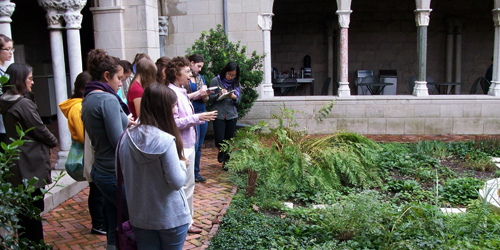
A delicious mixture of humanities and botany in one first-year seminar.
ARTH 175/BISC 175 First-Year Seminar: The Art and Science of Food in Italy, from the Renaissance to the Slow Food Movement
Kristina Jones, director of the Wellesley College Botanic Gardens and faculty in biological sciences and environmental studies, and Jacki Musacchio, associate professor of art, co-teach this seminar in which students analyze everything from food as a sexual metaphor in Italian art to the chemistry of cooking itself.
This new course evolved from an advanced art history seminar Musacchio taught last year, and incorporates presentation/discussion sessions as well as hands-on laboratory activities and visits to farms, libraries, and museums, both on and off campus.
Indeed, part of the course’s appeal is the extent of hands-on experiences it provides. Even before the semester began, summer interns planned and maintained the Italian Food Garden specifically for the class, including crops with a strong history in Italian agriculture and cuisine. During the course, each student selected a crop and researched its history and representation in Italian art as well as its horticultural requirements and botanical relationships, and made a Renaissance-era recipe with the crop as part of their presentation to the class.
Classes also met in the Davis Museum and the Book Arts Lab, where students closely examined works of art and their relationship to Italian food culture while they learned about the complex techniques behind the creation of both. Field trips ranged from Professor Heather Matilla's research bee colony on campus (where, as Gabi Guzman '15 says, students “got the chance to ‘pet’ the bees with our bare hands and dip our fingers into the honey, both while the bees were still on the honeycomb sheet”) to the Medieval Gardens at the Cloisters Museum and the New York Botanical Garden in New York City.
Jones and Musacchio summarize their experience using art, history, and science to cover food in all of its angles, from agriculture to cooking to nutrition to consumer culture to people's relationships to food and the material culture associated with it: "It's very exciting to see students make connections from class to class or subject to subject; we want them to leave the semester with the knowledge that both art and science provide a valid lens for understanding history if you have the background and tools to interpret them.”
“This course has completely revolutionized the way I view artwork and my attitude toward modern-day agricultural practices.”
—Abigail Golden '15

